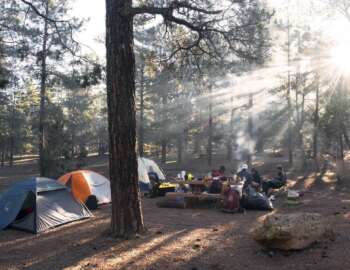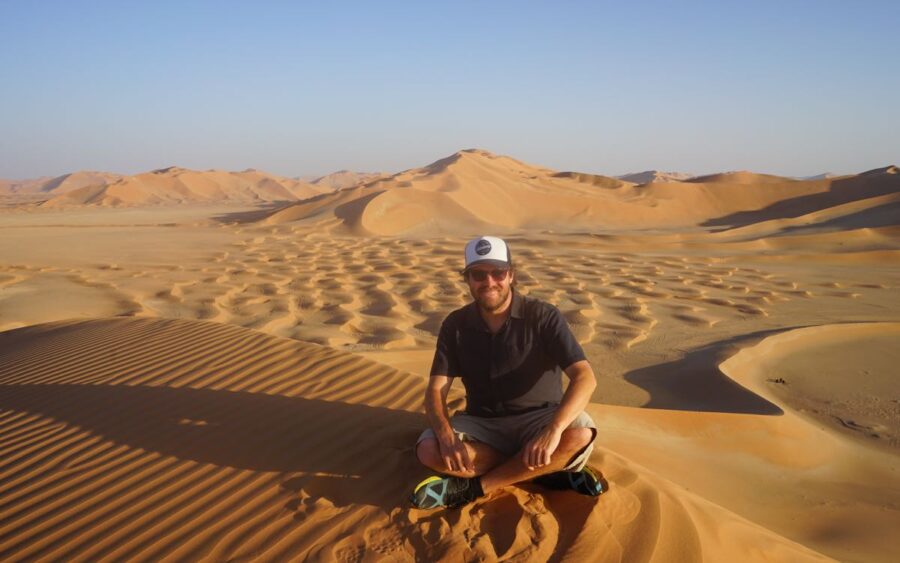Backpacking light is without a doubt the best way to go hiking and these days with many outdoor gear manufacturers making more lightweight gear it’s easier than ever.
When I first started hiking back in the mid-90s’ I tended to carry more than I really needed ‘just in case’ and also had access to limited gear that was lightweight.
Over the years I started to get rid of things I didn’t really need and managed to get some lighter-weight gear, especially regarding the backpack and sleeping bag situation.
The change was dramatic!
With a lighter load, I found myself walking more miles per day and much more comfortably. I was a convert to backpacking light.
Around 2008 I took it to the next stage and started accumulating ultralight hiking gear which completely transformed the hiking experience.
The boots were gone and only lightweight trail running shoes were used, even with a backpack carrying 5 days of supplies.
I was putting in over 20 miles a day (35 km) easily with no pain in the body, except for the usual slightly aching feet that can’t be avoided no matter what you do, it seems.
So here I’m writing my experiences and advice with the backpacking light mentality to hiking for those curious about the techniques and gear used.
Backpacking Light

The term backpacking light is generally used to cover all forms of lightweight backpacking, but in reality, it refers to what could be called “the middle ground” between heavy loads and the super-ultralight way of hiking.
Although I have tried super-ultralight hiking I found myself a bit too uncomfortable on longer hikes. It was fine for quick over-nighter camping out, but when doing a few weeks of hiking in one go I found the compromise between saving weight in the backpack to a less comfortable sleep too much.
I found the compromise between ultralight hiking and lightweight hiking to be the sweet spot for me overall.
However, everyone is different and will find their own ‘sweet spot’ for hiking gear weight and comfort.

Backpacking light gear can be on the expensive side depending on what you get but there is plenty of good gear you can get for a reasonable price, and it’s an investment for the long run.
You don’t want to be uncomfortable with cheaper gear, especially the backpack.
This is what I recommend for backpacking light gear overall. I’m not going into a massive gear list of many alternative options, just a rundown of what I like and what you may like as well.
1. The Backpack
The most important thing to do is to try out the backpack for backpacking light in a store if possible, and if not read reviews online of it that other experienced hikers have done.
Make sure if you order online that the seller has a refund policy if the backpack gets to you and you try it at home and find it not suitable.
I generally find that over time you will gain trust in particular outdoor brands and know that what you order should be good.
The backpack you get will depend on the kind of hiking you have in mind. If you’re planning just 2-3 days hiking then you won’t need a big backpack, but if you’re planning 5 days hiking carrying all food supplies.
However, many of the lightweight backpacks these days can be cinched down to a smaller size so if you got a bigger backpack for just a few day’s trips you could get a bigger backpack and do that, and it leaves you with a bigger backpack for when you may go on longer hikes.
There are many great backpack makers in the market these days and some of the best are cottage industries, such as Gossamer Gear in the United States, which make reliable ultralight backpacks.
Other good lightweight backpack companies, among many, are Laufbursche in Germany, Z Packs in the United States, and more.

2. The Sleeping Bag
The best sleeping bag for backpacking light should ideally be a down sleeping bag as they are more lightweight and packed down smaller.
Of course, it all depends on where you plan to hike. If you’re going to be mostly in warm places when camping then you won’t need a warm sleeping bag.
The best option when backpacking light is getting multiple uses from your gear. So you could get a sleeping bag that’s not too warm and sleep with your jacket on in it for extra warmth, which is what I do.
Another option is to use a down quilt, such as those made by Katabatic Gear in the United States.
3. The Tent
The tent for backpacking light can be a little more complicated as it depends on the style of camping you choose.
For example, there is the option of the 3 seasons lightweight tent but also the option of bivvy camping.
If you’re not sure what a bivy is it’s basically just a waterproof cover for your sleeping bag, although bivy bags can be slightly bigger than others which allows for you to squeeze your backpack in as well.
Bivy camping can generally be done alongside a small lightweight tarp for some added weather protection.
All the hiking I did in New Zealand was with a bivvy bag and it was a good experience, but then I was just doing 3-day hikes and then back to hostels for a few nights and then out again onto another trail.

The great thing about a bivvy bag is the small pack size and ease of setting up camp, plus they tend to be half the weight of a tent.
If going for an extended period of time out hiking when the tent will in effect become your ‘home’ then I would prefer a tent over the bivy bag. But for short trips a bivy bag is fine.
For the tent, it all depends if you are camping alone or with someone. If alone then obviously just get a 1-person tent that’s light. You can find plenty of lightweight tents under 1kg these days, some as light as 500 grams.
One good option is to get a lightweight tent that uses hiking poles as the main support as this will save you weight by not having to use tent poles.
I used a Six Moon Designs tent for a number of years that did just that and I found it practical and good, but wouldn’t use it in severe storm conditions as it would not be as stable.

When hiking in Denali National Park in Alaska I used my Big Agness tent as it was more suitable for stormy weather in remote places, and we did get hit by a severe storm when there,

4. Footwear
I’ve been using the same footwear brand since 2007 and won’t change it as they always have the right trail shoes for me that I know are comfortable and what size and style to always get.
I use the brand inov8. They are a British brand that makes exceptional outdoor shoes for different purposes. I love their trail running shoes for backpacking light.
But there are plenty of good shoe brands for trail shoes out there.
The big no-no in backpacking light is that you don’t wear boots!
Boots are heavy and trail running shoes can do the job perfectly fine and are much more comfortable and lighter.
5. Clothing

Get the clothing down to the basics!
That’s my biggest advice here. Don’t take all that extra clothing with you for that ‘added comfort’.
Just have what you need to wear while hiking and a change of top and socks for when comfortable at camp. There’s no need to bring excessive clothing at all.
You should always have a good jacket with you, preferably a down jacket due to their warmth to weight ratio, and it can also be used for sleeping, as I said before, to make your sleeping bag warmer.
Extra Gear
The gear you bring for backpacking light will depend on the conditions you will be facing.
For example, if you will be on an obvious hiking trail that other hikers use regularly you won’t need a GPS, but if you’re heading into more remote areas where you think the chances of losing the trail could happen, then a GPS could be a good thing to have along if anything just to be safe.
One of the best things I use when hiking is hiking poles as they are great at taking some stress off the knees and help keep balance in tricky trail conditions.
For a camping knife, you won’t need anything more than a simple pocket knife like a Swiss Army Knife, that is lightweight, small, and gets the job done.
You’re out hiking, after all, not doing bushcraft!
Backpacking Light
I hope that some of my insight into backpacking light has been not just informational but useful as well in helping plan for your own backpacking light trips.
I recommend using SafetyWing Travel Insurance for your trip, just in case, it’s best to be prepared.
For more hiking guides check out my hiking page.
Share the backpacking light advice:







Great post, very useful advice! Thanks for sharing all your wonderful packing ideas! Please keep up the great work. I have bookmarked this site.
What a useful tips you shared with us. It is really interesting and informative post. Thank you so much for sharing it.
This is such an amazing guide. Sharing your experience like these will definitely help a lot of people, including myself. Thank you so much for sharing this experience.
Thank you for sharing this wonderful backpacking idea and it really means to me and for others solo travelers. Thank you
An amazing guide you shared to enjoy to back bag for trip. these are necessary items which we should pack while we are planning a trip.
This is a very comprehensive post. I haven’t had the chance to do a round-the-world trip yet, though I’ve done a couple of mini-sabbaticals.
I will do another post about what to pack for hiking soon as well.
Thank you for sharing this wonderful backpacking idea. Great post!
Amazing post. I like to read to blog. And i’m now buying this sony dsc-rx100m2 to start my vlogging stories again.
Great. Good luck with your vlogging!
This was a really interesting post, thanks for sharing your travel experience.
Bogomolets National Medical University is top ranked government university. It is recognized by MCI, WHO, IMED & UNESCO. Affordable fee structure with quality education. BNMU Ranking & Review Ukraine.
bogomolets national medical university, O.O. Bogomolets National Medical University, Bogomolets National Medical University, Study Mbbs in Bogomolets National Medical University, Bogomolets National Medical University Ranking & Review.
Pingback: Taroko Gorge Hiking - Trip Report - Backpackingman
Pingback: Merkato Market in Addis Ababa (A Visit to Africa's Largest Market)
Polyurethane Hose manufacturer, PU Hose, Textile Machinery Spares, Hoses, India
Flexaflex Hoses – We are leading manufacturers and suppliers of PU Hose, Textile Machinery Spares, PVC Duct Hose and Polyurethane Hose in India. Soldering fume exhaust hose, Santoprene hose, OHTC blow hose, Braided hose, Suction Hose, Ahmedabad, Gujarat.
Polyurethane Hose manufacturer, PU Hose
Pingback: Yakushima Island (Hiking In The Mystical Shiratani Unsuikyo Forest)
Pingback: Montane Featherlite Down Jacket Mens and Womens Review
Pingback: Backpacking Tanzania (Travel Guide) - Backpackingman
Pingback: The Scuba Diver Life in Dahab, Egypt - Art of Scuba Diving
Pingback: REVIEW: Slicks Carry On Backpack - Backpacker Banter
Pingback: Today's the Day I Quit My Job to Go Travelling
Pingback: 6 Camping Essentials You Must Bring On Your Next Trip - Backpackingman
Pingback: Wild camping in Dartmoor National Park | Travel Hacker Girl